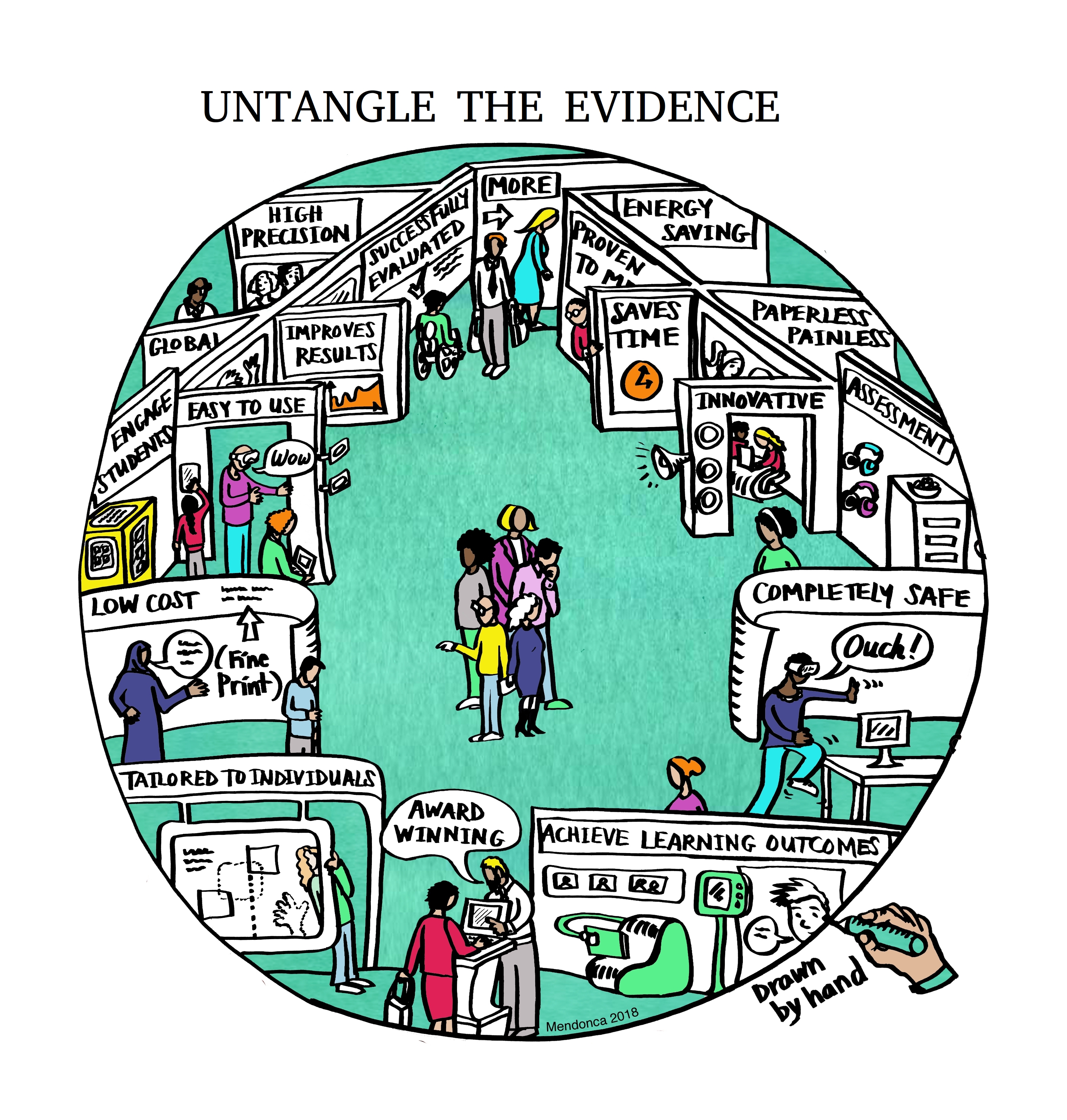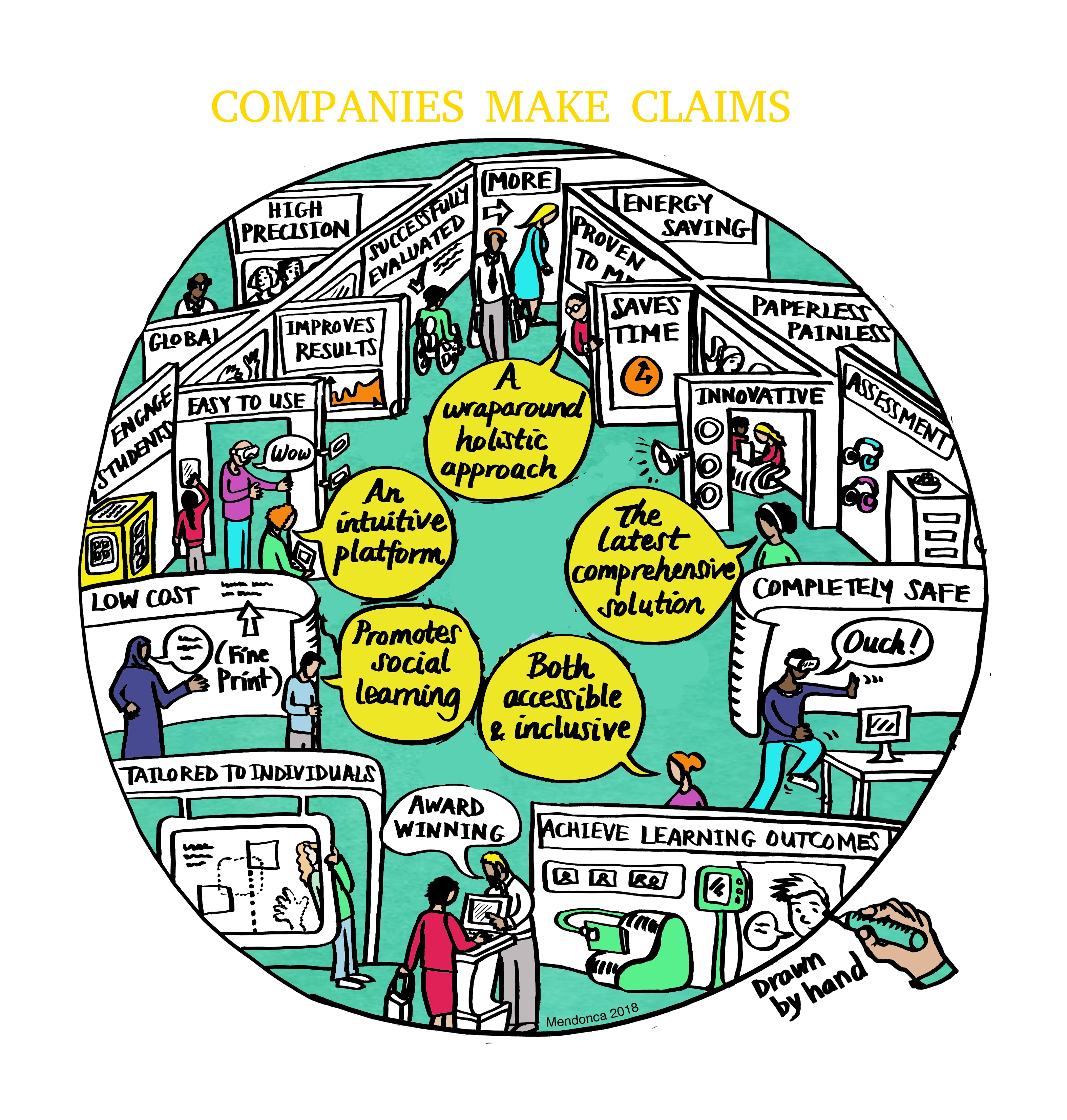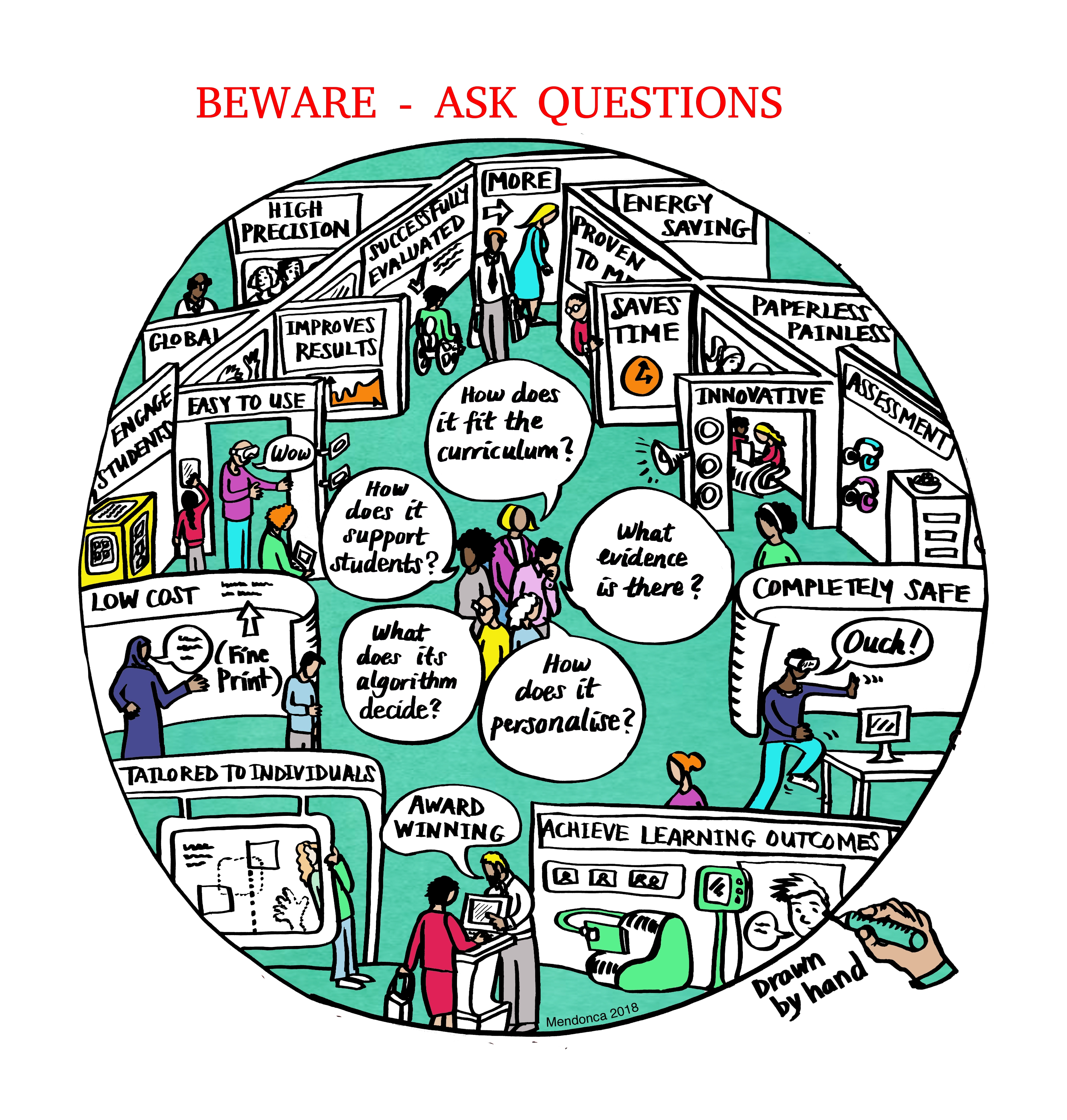Technology-enhanced Personalised Learning
This study demonstrates the great potential of technology in implementing effective personalised learning. Nevertheless, it is not clear yet whether practical implementation actually works.The promise of technology-enhanced personalised learning is worth pursuing, and some tools have been built that respond to individual learning needs, aiming to reduce achievement gaps, or to put the student in control of their learning. However, the evidence also clearly shows that technology-enhanced personalised learning is not a silver bullet. We hope this study can make a valuable contribution to improving the quality of teaching in German schools and elsewhere.
 Click on the image to learn more
Click on the image to learn more
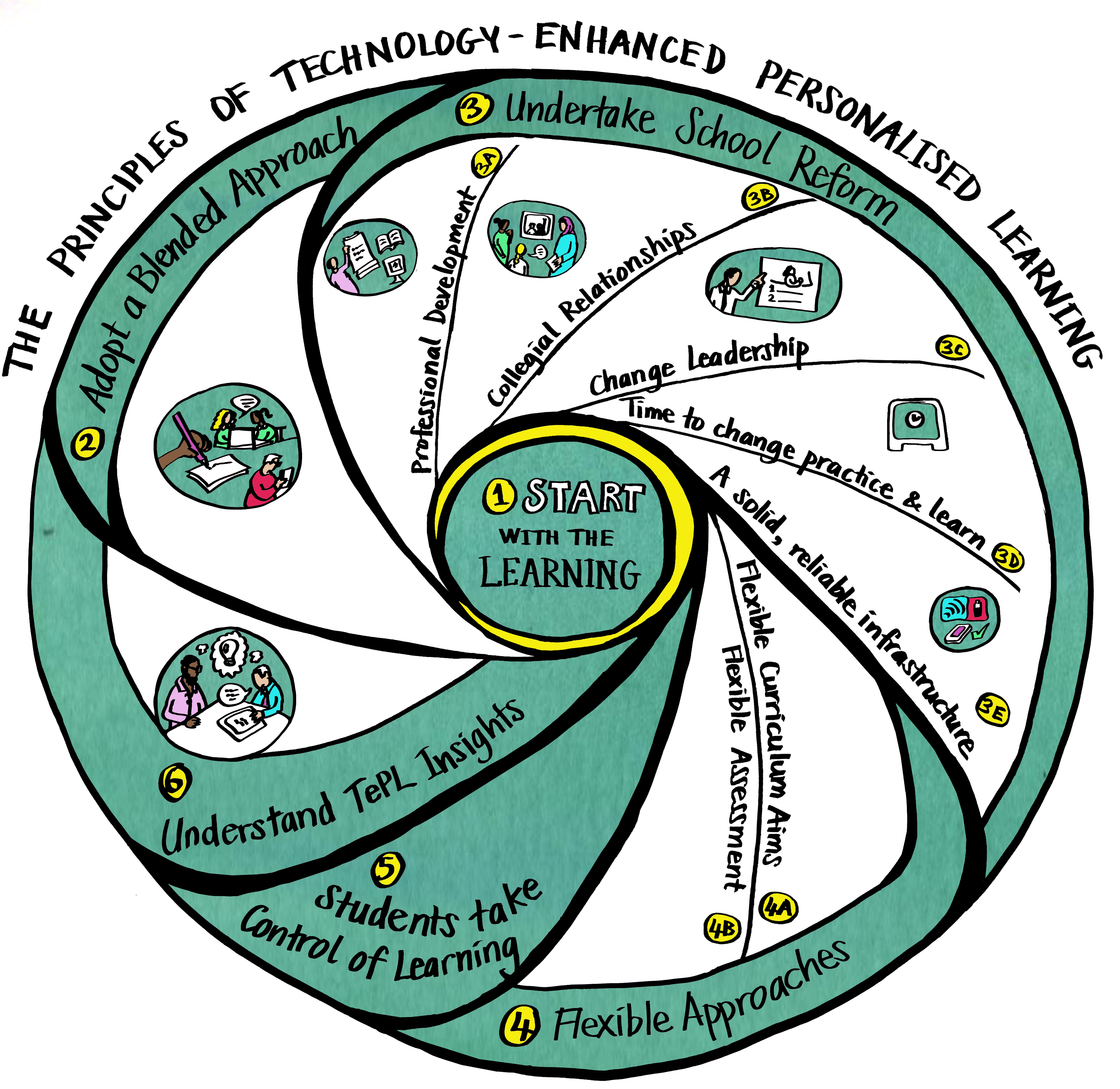
Dimensions of Technology-enhanced Personalised Learning
What is meant by personalised learning is complex. For example, personalised learning can mean different things (such as independent learning or individual competencies) in different contexts, while it particularly depends on who makes the decisions (policymakers, teachers or students).
One way through this complexity is to consider personalised learning in terms of its multiple dimensions, that is the personalisation of why, how, what, when, who, and where.
To learn more about this and other issues, read the report.
 Click on the jigsaw pieces to learn more
Click on the jigsaw pieces to learn more
Implementation Challenges
- Implementation needs to be considered as part of whole-school reform, with training and time allowances for new practices to settle.
- Regardless of the vision, existing inequalities may be reinforced not reduced.
- Protecting student Internet safety can be in opposition to enabling students to take active control of their own learning.
- Technology-enhanced personalised learning can be at the expense of inclusive support for the class, and social learning opportunities for all students.
- Infrastructure requirements can be a huge challenge when implementing technology-enhanced personalised learning (e.g., what does a teacher do when the technology stops working, as it all too often can do).
- Technology-enhanced personalised learning can require massive amounts of student data, which can compromise student privacy.
- Algorithms can reproduce existing stereotypes.
- Technology-enhanced personalised learning has nothing to say about the why question (why something in particular needs to be learned).
- Technology-enhanced personalised learning also has nothing to say about the how question (how something is to be learned). Many use a didactic or instructionist approach to learning that in conventional classrooms is often avoided.
To learn more about this and other issues, read the report.
Things to question
- How will this particular technology help me achieve curriculum aims, and how is it aligned to curriculum objectives and assessment criteria?
- How will this particular technology support students to achieve their full potential?
- How does the proposed technology work in simple terms, what do its algorithms do, what data it does it use, and how does it use that data?
- How will this particular technology fit with existing infrastructure (e.g. Internet bandwidth or existing computers), and what will need to be adjusted or replaced?
- Ask about logins (for example, how are student passwords, or other methods of secure access, managed?).
- Who would be accountable for dealing with everyday queries from teachers and troubleshooting?
- Ask about the costs (the technology, your investment in time, students’ investment in time, technical support).
- How much time is recommended for professional development? Is it included in the purchase costs?
- How can I be supported in planning my lessons, so that I use the technology to best effect?
- How can I monitor student usage (not just how much time they are using it, but their achievements and misconceptions) without impacting on student agency?
- How does the system personalise the learning approach (the how dimension)?
- How the system personalises the learning content and the learning pathways (the what dimension)?
- How does the system enable appropriate learning groups (the who dimension)?
- How does the system enable appropriate learning contexts (the where dimension)?
- Always recognise that the personalisation of why something is to be learned depends on the policymakers.
To learn more about this and other issues, read the report.



Tools Gallery


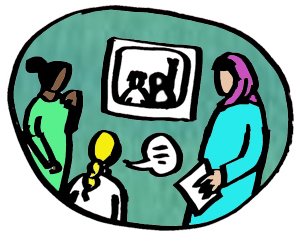
Cognitive Tutor
-
 Tag: ITS
Tag: ITS -
 Domain: Maths
Domain: Maths -
 Age(s): 13 - 17
Age(s): 13 - 17 -
 Language(s): English
Language(s): English -
 Cost: unknown
Cost: unknown -
 Impact: §
Impact: § -
 Evidence: @@@
Evidence: @@@
Cognitive Tutor is a suite of technology-based mathematics curricula with textbook materials and an automated computer-based cognitive tutor for each course. Individualised instruction is built into the software. Students engage with real-world problem solving and are supported to progress from concrete to abstract thinking.The company provides a comprehensive range of materials, within which the Cognitive Tutor software plays a relatively small part.
The developers recommend that students spend two days per week of their class time using the computer-based individualised software, while the teacher works with individual students as needed, and three days on classroom group-based activities, guided by the teacher and textbook. Visit the website
WriteToLearn
-
 Tag: ITS
Tag: ITS -
 Domain: Literacy (essay writing)
Domain: Literacy (essay writing) -
 Age(s): 12 - 13
Age(s): 12 - 13 -
 Language(s): English
Language(s): English -
 Cost: unknown
Cost: unknown -
 Impact: unknown
Impact: unknown -
 Evidence: @
Evidence: @
WriteToLearn is a web-based writing environment that uses Artificial Intelligence techniques to automatically respond to student’s writing. It also provides prompts and summaries of texts in order to build reading comprehension, scores the writing, and provides writing advice based on three rubrics.
Visit the website
busuu
-
 Tag: Learning network orchestrator
Tag: Learning network orchestrator -
 Domain: Language learning
Domain: Language learning -
 Age(s): any
Age(s): any -
 Language(s): Germ., Engl., Span.
Language(s): Germ., Engl., Span. -
 Cost: €
Cost: € -
 Impact: unknown
Impact: unknown -
 Evidence: @
Evidence: @
busuu is a language learning app that offers courses in German, English, Spanish and nine other languages, at CEFR levels A1, A2, B1 and B2. Features include study materials, a vocabulary trainer, enhanced grammar units, and instruction in the four language skills of reading, writing, listening and speaking.
busuu encourages collaborative learning by connecting users with native speakers of their target language. Every busuu user acting both as a student of a foreign language and as a tutor of their own mother tongue. In the recently added PRO platform, instructors can create classrooms, invite students, access the full busuu curriculum and follow student progress in an interactive dashboard.
Visit the website
ASSISTments
-
 Tag: ITS
Tag: ITS -
 Domain: Maths
Domain: Maths -
 Age(s): 12 - 13
Age(s): 12 - 13 -
 Language(s): English
Language(s): English -
 Cost: €
Cost: € -
 Impact: §§§
Impact: §§§ -
 Evidence: @@@@
Evidence: @@@@
ASSISTments is a free online Intelligent Tutoring System designed to be used for mathematics homework. While other ITS typically lead to students progressing at different rates in the classroom, which can make the teacher’s job more difficult, ASSISTments is designed to help students catch up in the evenings, so that in the classroom everyone remains roughly in synch.
Students receive personalised pathways through the materials, supported by personalised and immediate feedback and hints. The system also provides teachers with reports about students’ progress. Visit the website
Maths-Whizz
-
 Tag: ITS
Tag: ITS -
 Domain: Maths
Domain: Maths -
 Age(s): 6 - 15
Age(s): 6 - 15 -
 Language(s): English
Language(s): English -
 Cost: unknown
Cost: unknown -
 Impact: unknown
Impact: unknown -
 Evidence: @
Evidence: @
Maths-Whizz is an online ITS for mathematics that assesses each student across multiple topics and then sets a programme of learning. It includes active teaching, interactive exercises and tests of the student’s level of understanding. Students progress through the system based on the answers that they give, the time that they take and the level of encouragement that they need.
Parents and teachers have access to reports in real-time, that gives visibility to each student’s strengths and weaknesses and can also be used to inform future teaching.
Visit the website
AltSchool
-
 Tag: Smart LMS
Tag: Smart LMS -
 Domain: any
Domain: any -
 Age(s): 5 - 14
Age(s): 5 - 14 -
 Language(s): English
Language(s): English -
 Cost: €€€€€
Cost: €€€€€ -
 Impact: unknown
Impact: unknown -
 Evidence: unknown
Evidence: unknown
ALTSchool use a whole-school Big Data-driven approach to deliver individualised learning to students. Students are given an individual playlist of 25 activities that are designed to encourage increasing amounts of student autonomy over what they work on and when. Teachers have an online dashboard, which gives them access to information about students strengths, weaknesses and progress, and to video footage of classroom activities captured by classroom wall-mounted cameras.
ALTSchool is a for-profit venture founded by a former Google executive and funded by the Chan Zuckerberg Initiative (in other words, it has emerged from Silicon Valley). Interestingly, only around half the staff in ALTSchool are educators while the other half are technologists.
Visit the website
Accelerated Reader
-
 Tag: ITS
Tag: ITS -
 Domain: Literacy
Domain: Literacy -
 Age(s): 12 - 13
Age(s): 12 - 13 -
 Language(s): English
Language(s): English -
 Cost: €€€€
Cost: €€€€ -
 Impact: §§§
Impact: §§§ -
 Evidence: @@@
Evidence: @@@
Accelerated Reader is a progress-monitoring, assessment, and practice tool that aims to support reading instruction. The software includes information on 2,000 books, helping students choose ones that are consistent with their interests and abilities. It also facilitates goal setting, monitors students’ understanding of what they read, and provides individualised feedback.
The system works by showing the student a bookshelf of titles from which they choose. Then, later, when they’ve finished reading the book, the student answers a quiz. The more the student reads and the more quizzes they answer, the better the software adapts to the individual student’s abilities and interests. The teacher has access to diagnostic reports of class and individual performance.
Visit the website
Third Space Learning
-
 Tag: Learning network orchestrator
Tag: Learning network orchestrator -
 Domain: Maths
Domain: Maths -
 Age(s): 10 - 11
Age(s): 10 - 11 -
 Language(s): English
Language(s): English -
 Cost: €€€€€
Cost: €€€€€ -
 Impact: unknown
Impact: unknown -
 Evidence: @
Evidence: @
Third Space Learning uses technology to connect math tutors from India and Sri Lanka to children at risk of failure in mathematics in primary schools across England. It supports online 1-to-1 tutoring, plus choosing the lessons and receiving regular progress reports. The system introduces tutors to the student profile and the UK education system.
Before each session, the student’s usual classroom teachers are able to select lessons from the Third Space Learning mathematics curriculum, to target individual learning needs. Tutors and students communicate with each other using a secure virtual classroom with two-way audio and a shared whiteboard.
Visit the website
Smart Learning Partner
-
 Tag: Learning network orchestrator
Tag: Learning network orchestrator -
 Domain: all
Domain: all -
 Age(s): all
Age(s): all -
 Language(s): Chinese
Language(s): Chinese -
 Cost: €
Cost: € -
 Impact: unknown
Impact: unknown -
 Evidence: unknown
Evidence: unknown
Smart Learning Partner involves two key parts. First, it is a smart learning management system, incorporating a repository of online videos covering all subjects and school levels, and a suite of artificial intelligence tools that adapt the content as students progress through the system. Second, it is a mobile platform that enables students to connect with one of thousands of tutors via their mobile phones.
The student uses the app at any time of the day or night to search for a tutor, all of whom have been rated by other students, to ask them specific questions about a school topic for which they need help. They choose their tutor and get 20 minutes of one-to-one mobile online tuition (sharing only voice and screens), helping them through the problem area.
Visit the website
IBM-Watson Education Solutions
-
 Tag: ITS
Tag: ITS -
 Domain: all
Domain: all -
 Age(s): all
Age(s): all -
 Language(s): English
Language(s): English -
 Cost: unknown
Cost: unknown -
 Impact: unknown
Impact: unknown -
 Evidence: unknown
Evidence: unknown
The IBM-Watson Education Solutions software uses artificial intelligence algorithms that answer questions posed in natural language. It aims to provide teachers with a toolset to support adaptive education in order to improve educational outcomes.
The system enables teachers to monitor student progress during lessons, supports lesson planning, and gives advice about what to include based on student needs. It uses a model of the whole learner to generate suggestions on how best to help each student in the classroom, so that students receive targeted support more quickly.
Visit the website
Spectra
Secondary
School
-
 Tag: Smart LMS
Tag: Smart LMS -
 Domain: all
Domain: all -
 Age(s): 11 - 16
Age(s): 11 - 16 -
 Language(s): English
Language(s): English -
 Cost: unknown
Cost: unknown -
 Impact: unknown
Impact: unknown -
 Evidence: unknown
Evidence: unknown
Spectra Secondary School is a mathematics and ICT specialist school that caters for some of the lowest performing students in Singapore. It uses an approach designed to support student diversity, student self-pacing, and student choice, with students being encouraged to learn independently.
The school rewards students based on effort rather than academic results. The school has developed their own smart LMS, which includes a knowledge map that links up all of the school’s teaching resources. The LMS also records student progress and suggests individualised learning pathways. The school has adopted a flipped classroom approach.
Visit the website
Florida
Virtual
School
-
 Tag: Learning network orchestrator
Tag: Learning network orchestrator -
 Domain: all
Domain: all -
 Age(s): all
Age(s): all -
 Language(s): English
Language(s): English -
 Cost: €
Cost: € -
 Impact: unknown
Impact: unknown -
 Evidence: unknown
Evidence: unknown
Florida Virtual School is a state-funded online school that caters for part-time students from all backgrounds (e.g. from schools and home-schooling) and of all school ages (from kindergarten through to 18 years old).
The school provides access to more than 150 online courses, each of which includes step-by-step video demonstrations, activities with corrective feedback, and interactive games, together with practice tests that match the Florida End of Course format. The system also provides opportunities for student collaboration through online messaging systems and video conferencing.
Visit the website
conText
-
 Tag: ITS
Tag: ITS -
 Domain: German Literacy
Domain: German Literacy -
 Age(s): Secondary Level I
Age(s): Secondary Level I -
 Language(s): German
Language(s): German -
 Cost: €€€
Cost: €€€ -
 Impact: §§§§§
Impact: §§§§§ -
 Evidence: @@@@@
Evidence: @@@@@
conText is an ITS designed to improve the reading comprehension of students at secondary level. The application contains 20 non-fiction texts of varying degrees of difficulty. It involves the students in an intense study of the texts. At the same time, it guides them how to represent the content of the original texts in a more compact, coherent and comprehensive way. The software is designed to encourage the acquisition of cognitive processes and strategies applied in reading comprehension.
Students are asked to write a summary of a text on the computer. conText provides personalised feedback, detailing whether individual sections are redundant or irrelevant, or whether key contents of the original text are missing. Students are then given the opportunity to improve their summaries.
Visit the website
bettermarks
-
 Tag: ITS
Tag: ITS -
 Domain: Maths
Domain: Maths -
 Age(s): Grades 4-10
Age(s): Grades 4-10 -
 Language(s): German, etc.
Language(s): German, etc. -
 Cost: €
Cost: € -
 Impact: §§§
Impact: §§§ -
 Evidence: @@@
Evidence: @@@
bettermarks is an adaptive learning software for maths lessons. Based on assessment tests and final exams, the student’s learning needs are determined. Furthermore, based on the students’ entries, the application determines potential knowledge gaps and provides individual educational content. For teachers, the programme offers overviews of the completion status and solution frequency of tasks performed by their students.
The exercises comprise adaptive learning tools, worked examples with explanations, different entry and visualisation tools, as well as intelligent error diagnosis with feedback customised to the respective error made. The system identifies equivalent solutions, accepts alternative approaches, and offers a high degree of flexibility.
Visit the website
DiLer
-
 Tag: (Smart) LMS
Tag: (Smart) LMS -
 Domain: all
Domain: all -
 Age(s): all
Age(s): all -
 Language(s): German
Language(s): German -
 Cost: €
Cost: € -
 Impact: unknown
Impact: unknown -
 Evidence: unknown
Evidence: unknown
The DiLer learning platform is an open source software. Its pedagogic objective is to support students in their independent, personalised learning activities. At the core of the platform is a competency grid in which competencies and learning levels can be freely chosen. This way, the platform allows teachers to put together individual packages of exercises and tasks for their students based on the competency grid. The platform provides online and offline exercises and tests with evaluations, as well as a display of progress.
Third-party offerings can be incorporated into curricula as well. Furthermore, the platform establishes several communication channels among students, between teachers and parents, as well as school organisation features. Teachers are also given access to a network of materials that can be applied to develop and exchange learning materials among each other.
Visit the website
Google Classroom
-
 Tag: Smart LMS
Tag: Smart LMS -
 Domain: any
Domain: any -
 Age(s): 6 - 15
Age(s): 6 - 15 -
 Language(s): English
Language(s): English -
 Cost: unknown
Cost: unknown -
 Impact: unknown
Impact: unknown -
 Evidence: unknown
Evidence: unknown
Using the Classroom tools, teachers can create classes, set individual assignments, and send feedback. The system also enables teachers to monitor student assignments. Also, Classroom tools offer students a choice of teaching materials, alternative tools to help them complete those materials, and opportunities to communicate directly with their teacher.
What particularly distinguishes Google Classroom is that it is designed to connect directly with a large variety of external tools. These include school management systems, interactive teaching tools, apps to improve reading and writing skills, apps to teach coding, and interactive videos.
Visit the website
Snappet
-
 Tag: (Smart) LMS
Tag: (Smart) LMS -
 Domain: Maths, German, German as second language, media literacy
Domain: Maths, German, German as second language, media literacy -
 Age(s): Grades 1-6
Age(s): Grades 1-6 -
 Language(s): German
Language(s): German -
 Cost: €€€€€
Cost: €€€€€ -
 Impact: §§§
Impact: §§§ -
 Evidence: @@@
Evidence: @@@
Snappet is a learning platform for primary schools with a learning offering aligned with the curricula of the various German states, focusing on maths and German. If required, Snappet can also provide schools with tablet PCs and Internet access.
The platform offers students' individual learning status so that teachers can identify students needs for support and assign personalised exercises to them to work through on the platform. The platform can also adapt the level of difficulty of the tasks based on the learners’ input and/or suggest competency elements for further exercise.
Visit the website
Kapiert.de
-
 Tag: (Smart) LMS)
Tag: (Smart) LMS) -
 Domain: Maths, German, English
Domain: Maths, German, English -
 Age(s): Grades 5-10
Age(s): Grades 5-10 -
 Language(s): German
Language(s): German -
 Cost: €
Cost: € -
 Impact: §§§§§
Impact: §§§§§ -
 Evidence: @@@@@
Evidence: @@@@@
Kapiert.de is a textbook-based learning platform developed by the school book publishers Westermann, Schroedel and Diesterweg for maths, German and English. It offers additional interactive exercises and explanatory videos to supplement the textbooks of the individual publishers. Furthermore, the software creates personal support plans on selected topics based on diagnostic tests.
For extracurricular exercise sessions and as a tutoring platform, a personal video chat with a tutor can be added. For in-school use, the platform allows teachers to assign specific educational videos, interactive exercises and training courses to their students and view their completion status and solutions.
Visit the website
Recommendations for research and practice
Most funded innovation projects usually aim at the development of a technology rather than its robust evaluation. Evaluations tend to focus on usability and student attitudes in small settings, rather than effectiveness and sustainability at scale.
- Developers and researchers should consider using a design-based research approach, to produce effective educational interventions combined with theory.
- Teachers, students, and parents should be involved in the heart of the research and development process.
- The research and development process should include both ongoing formative and summative evaluations at scale, using both qualitative and quantitative approaches.
Recommendations for policy-makers, foundations and NGOs
- Governments and philanthropists should consider guaranteeing longer-term funding and a market for TEPL tools that have been shown to work in real life settings (albeit at small scale).
- Policy-makers and funders should consider funding capacity building (including teacher training), helping to ensure that technology-enhanced personalised learning research is both sustainable and cumulative: projects should be funded that build on previous innovations, as well as intelligent evaluation in real world settings at scale.
- A range of stakeholders should be involved throughout a research project’s life.
To learn more about this and other issues, read the report.








